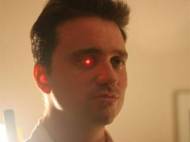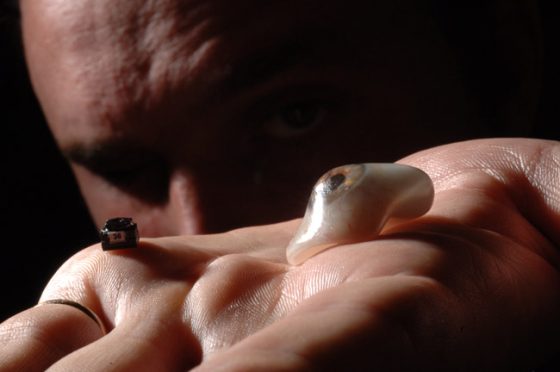Bionic eye – Eyeborg
 Canadian filmmaker Rob Spence damaged his right eye as a 13-year-old while playing with his grandfather’s gun, and eventually had surgery to wear a non-functional prosthetic eye. Engineer Kosta Grammatis has succeeded in placing a working red LED in Spence’s eye giving him a look similar to the star cyborg in The Terminator. It is the first time the team has fitted a working electronic device, complete with power source, into the eye socket.
Canadian filmmaker Rob Spence damaged his right eye as a 13-year-old while playing with his grandfather’s gun, and eventually had surgery to wear a non-functional prosthetic eye. Engineer Kosta Grammatis has succeeded in placing a working red LED in Spence’s eye giving him a look similar to the star cyborg in The Terminator. It is the first time the team has fitted a working electronic device, complete with power source, into the eye socket.
An LED may even be fitted alongside the camera in the final Eyeborg prosthetic if the battery can spare enough power. Apart from the aesthetic value, it could provide lighting in dark conditions.
His current bionic eye design contains a wireless video camera sandwiched between two layers of a prosthetic eye. That was the brainchild of Kosta Grammatis, a former engineer for the rocket firm SpaceX, who has crashed in Spence’s “spare bedroom lab” for the past few weeks.
Grammatis scrounged his components for the tiny video camera system from anywhere and everywhere. The wireless transmitter is the same as those used in small unmanned aerial vehicles deployed by the U.S. military, while the camera came from the tip of a colonoscopy instrument. Batteries came from Bluetooth headsets.
“Now it’s a matter of wiring it together and we’ll have a working prototype,” Grammatis told that adding that the tiny camera was successfully transmitting images up to four feet away. Spence would wear a transmitter elsewhere on his body to boost the signal and send it to a hard drive, and eventually upload the information in real time to the Internet. People from all over the world might then see from Spence’s perspective.
The project may not represent a huge technological innovation, but it does address the engineering challenge of squeezing a camera system into a tiny space. Current artificial vision systems designed by researchers at Johns Hopkins and other universities require people to have eye implants and wear bulkier cameras on eyeglasses.
Still, researchers are creating even smaller, high-performance “eye” cameras. A team from the University of Illinois and Northwestern University announced the creation of a tiny camera based on an array of silicon detectors and electronics embedded in stretchable, interconnected mesh. That work was detailed in the August 2008 issue of Nature.
Spence’s effort currently runs on a shoestring budget backed by techies volunteering their time and expertise. Companies such as OmniVision have donated some product samples, but no one has stepped forward to offer funding yet.
Grammatis spoke wistfully of joining forces with artificial vision researchers to tackle the issue from both sides, and perhaps taking another step closer to robot-human convergence.
Clunky artificial vision systems have begun restoring limited vision to blind people. But a one-eyed filmmaker wants to look at cyborg enhancement differently by wearing a bionic eye camera.
Robert Spence plans to create a documentary on his experience of trying to become “EyeBorg”. Under development, his bionic eye is relatively thin and would sit on a peg embedded in his right eyeball, meaning that it could move left, right, up and down. Rather than restoring vision to his busted eye, “EyeBorg” represents an effort to shrink wearable technologies and embed them, unnoticed, as part of the human body.










Good Invention.
Dr.A.Jagadeesh Nellore(AP),India
author
Here’s a recent update from the EyeBorg website:
We’ve been busy behind the scenes here at Eyeborg HQ for the last few months but the time has come. We’re lifting the lid on what we’ve been working on!
To celebrate the launch of their new video game “Deus Ex: Human Revolution”, Square Enix have commissioned Eyeborg to investigate prosthetics, cybernetics and human augmentation and ask: how far are we from the future presented in the game?
http://www.youtube.com/watch?v=TW78wbN-WuU
Great and a very useful blog for me. I read your story and got to know about the artificial eye. Thanks a lot for sharing such a informative blog. Keep sharing.